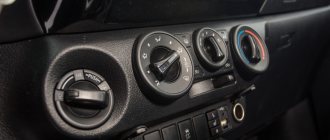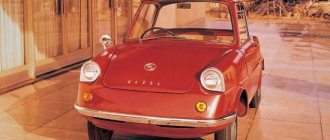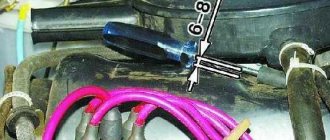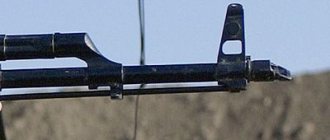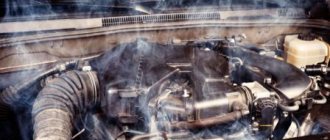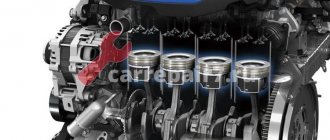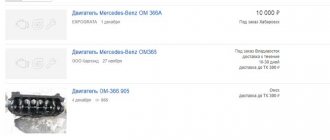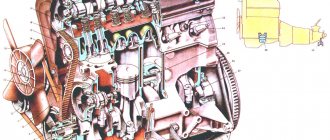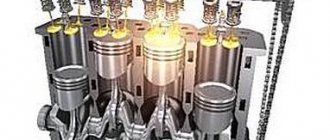HBO on a turbo engine: capabilities, advantages and disadvantages
The active development of the engineering industry leads to the production of more high-performance cars. Thanks to the implementation of a number of design solutions related to turbocharging, the small-volume engine produces good power. However, this inevitably leads to increased gasoline consumption. Installing HBO on a turbocharged engine is a profitable solution for the car owner. Before contacting a car repair shop, it is advisable to understand the nuances of converting a turbo engine to gas.
Advantages of an opposed internal combustion engine
By and large, the operation of a boxer engine is no different from the principle of operation of units of other designs. However, this arrangement of cylinders has its certain advantages, as well as disadvantages.
The most noticeable advantage of the power plants under consideration is the almost complete absence of vibration during operation. This effect is achieved due to the arrangement of the pistons, which balance each other. This not only adds comfort, but also significantly increases service life. This is where the second “plus” comes from; Impressive life of the boxer engine. There is evidence that quite often the mileage before the first major overhaul was at least 500 thousand kilometers. Of course, driving style makes significant adjustments. And, nevertheless, the time between repairs is quite long. However, quite often you can come across statements from experts and car enthusiasts that 800-900 thousand before the first major overhaul is nothing more than a beautiful fairy tale; The motors of the design discussed in this article provide cars with a low center of gravity. This quality is especially valued in powerful sports cars.
After all, when taking turns at high speeds, it is very important to maintain stability; Also, one cannot fail to mention the saving of space under the hood. Although this point will seem controversial to many, because to gain in height, you need to make the hood wider or longer.
That, perhaps, is all the significant advantages of opposition speakers. Now we need to consider the disadvantages, of which, unfortunately, there are several more.
Pros of a boxer engine
The boxer engine design also has another name: “V-shaped engine with a cylinder angle of 180 degrees.” As we have already mentioned, “opposite” is about the military and about sports.
The love for boxer engines came not from a love of practicality or other consumer qualities, but purely from technical features:
✔ Low center of gravity;
✔ No vehicle vibrations;
✔ Passive safety in an accident.
Stability on the road is ensured by the fact that the motor, which is a flat “plate”, is placed at the lowest point of the car. The center of gravity shifts, so the car holds the road much better, and the driver feels more confident.
Placing horizontally arranged cylinders in a small box closer to the bottom was a breakthrough for motorsport - it was not without reason that Subaru was known as rally champions.
Comfort for passengers is higher due to the fact that the cylinders balance each other during operation, and thus independently dampen vibrations. As for safety in accidents, the location and design of the boxer engine prevents it from flying into the cabin in a strong collision and causing harm to people sitting in front. Much more often, “opposite” drivers fall out onto the road. This, of course, is also sad, but the risk that people will get hurt is lower.
How to Avoid Costly Boxer Engine Repairs
Any boxer engine has pros and cons, which is quite natural. To avoid problems, the elimination of which may require very serious material costs, it makes sense to listen to the advice of specialists and operate a car with an installed boxer engine correctly
The first thing you should pay close attention to is strict adherence to maintenance schedules, which should be carried out at specialized stations and only by qualified personnel
Great care should be taken when choosing engine oil. Preference should be given only to well-known brands; purchases should be made either in specialized stores with an impeccable reputation or in branded service centers. Using a low-quality product can cause a lot of trouble for an overly economical driver. The same can be said about the quality of fuel. Fuel containing large amounts of “unauthorized” additives seriously reduces engine life, leading to the need for expensive repair work.
Many car owners who purchase vehicles with a boxer engine have heard about the high-quality and efficient cooling system, so they do not focus too much on this point. You should not drive the engine mercilessly, especially in the warm season - the most advanced cooling system may not cope with its task. To a large extent, difficult cooling is also caused by the lack of periodic engine washing - accumulating dirt on the motor significantly impedes heat transfer, contributing to excessive heating.
Despite some difficulties, the boxer engine has proven itself to be excellent, significantly increasing driving comfort and safety. It should be noted that the prevailing opinion about the extreme high cost of owning a car with such an engine is clearly exaggerated. For example, we can consider the Subaru brand, which has been producing cars with this type of engine for a long time - they have never been among the cars with excessively expensive maintenance, and many cars with standard engines cost their owners much more. This also affects significant savings on fuel, which is required much less - depending on the specific car model, fuel savings can reach up to 50%.
- Design and principle of operation of the speed sensor
- Why is there a lot of pressure in the engine cooling system or no pressure at all?
- Operating principle of a diesel engine
- How to install a 220 V engine preheater
Line of power units
Despite the fact that there were only two basic units, the model boasts many engine modifications. Each generation provides a wide selection of motors of varying power.
1st generation, SF (1997 - 2002)
- EJ20J (125 hp) - 2.0 l;
- EJ20E (137 hp) - 2.0 l;
- EJ205 (170 hp) - 2.0 l;
- EJ205 (177 hp) - 2.0 l;
- EJ25D (167 hp) - 2.5 l;
- EJ205 STI (240 hp) - 2.0 l;
- EJ255 STI (250 hp) - 2.5 l.
2nd generation, SG (2002 - 2007)
- EJ202 (125 hp) - 2.0 l;
- EJ203 (140 hp) - 2.0 l;
- EJ204 (158 hp) - 2.0 l;
- EJ205 (177 hp) - 2.0 l;
- EJ251 (167 hp) - 2.5 l;
- EJ253 (173 hp) - 2.5 l;
- EJ255 (210 hp) - 2.5 l;
- EJ255 (230 hp) - 2.5 l;
- EJ255 STI (265 hp) - 2.5 l.
3rd generation, SH (2007 - 2013)
- EJ204 (148 hp) - 2.0 l;
- FB20 (150 hp) - 2.0 l;
- EJ205 (230 hp) - 2.0 l;
- FB25 (173 hp) - 2.5 l;
- EJ255 (210 hp) - 2.5 l;
- EJ255 (230 hp) - 2.5 l;
- EJ 255S-Edition (263 hp) - 2.5 l.
Description
The first boxer engine was created by Ogneslav Kostovich in the 80s of the 19th century to equip the Rossiya airship. In the 20th century, a two-stroke boxer engine was designed and patented, which was highly appreciated by craftsmen from Europe.
Boxer engine.
After certain modifications, the engine was installed on motorcycles, light aircraft and domestic tanks. In the post-war period, such companies as Porsche, VW, Subaru and AlfaRomeo were interested in the unit.
Compared to early models and prototypes, the current engines have undergone a series of modifications and improvements that continue to this day thanks to FujiHeavy Industries.
Subaru experimented with the number of cylinders, and found the best option - a 6-cylinder engine. The most famous models of opposed units are:
- “Boxer” - pistons are constantly equidistant from each other;
- OROS - Opposed Piston Opposed Cylinder - the pistons move in pairs towards each other.
- 5 TDF - two-stroke multi-fuel internal combustion engine.
In fact, the process of operation of engines of this type does not differ from the operation of units of another type of design. In turn, this arrangement of cylinders has its advantages, as well as disadvantages.
Subaru boxer engine.
Let's look at some technical characteristics of the boxer engines that were installed on Subaru:
EJ 25 2.5
| Name | Characteristics |
| Manufacturer | Gunma Oizumi Plant |
| Motor brand | EJ 25 2.5 |
| Volume | 2.5 liters (2457 cm3) |
| Power | 155-300 hp |
| Cylinder diameter | 99.5 |
| Number of cylinders | 4 |
| Number of valves | 16 |
| Compression ratio | 8.2 (EJ257) 8.4 (EJ255) 8.7 (EJ257) 9.5 (EJ25D 1996) 9.7 (EJ25D 1997-1999) 10.1 (EJ251/EJ252/EJ253) 10.7 (EJ254) |
| Fuel consumption | 10.4 liters for every 100 km in mixed mode |
| Engine oil | 0W-30 5W-30 5W-40 10W-30 10W-40 |
| Resource | 250+ thousand km |
| Applicability, except Forester | Subaru Impreza (WRX/STI) Subaru Legacy/Outback Subaru Baja SAAB 9-2X |
Advantages
Compactness. The development of this type of engine began precisely with the desire to save as much space as possible under the hood, and reducing the height made it possible to achieve the desired goal.
Location of the main elements of the boxer engine.
Almost complete absence of vibration is achieved due to the “opposite” placement of the pistons.
The average engine life is from 500,000 km to the first CD. Of course, this number is influenced by driving style, and you can meet the “lucky” ones who lived to 800,000.
This design provides a low center of gravity, which is especially valuable in sports cars that need to provide high stability.
Flaws
The most significant problem for owners of Subarov boxer cars is the high cost of maintenance and the impossibility of making “home” repairs. We also notice the fact that due to the large number of modifications of motors, it is not possible to interchange parts.
The process of grinding the crankshaft journal, which must be performed using non-special equipment, also causes inconvenience. Don’t forget about the increased engine oil consumption compared to in-line “colleagues”.
Disadvantages of a boxer engine
First of all, it is worth pointing out the high cost of maintenance and the almost complete impossibility of performing repairs at home. Even a simple replacement of spark plugs requires special equipment. At the same time, it is difficult to find a sufficiently qualified specialist in third-party car services to repair a boxer engine. By the way, it would also be appropriate here to highlight the huge number of modifications of units, even within the same brand. This is the “sin” of, for example, the Subaru brand, which today is the main manufacturer of engines of this type. Of course, this position complicates repairs, since the ability to interchange parts is reduced to a minimum.
The cost of a new car with a boxer engine may be significantly higher than the cost of a car of the same configuration, but with a more traditional type of internal combustion engine. And the whole point is in the costs of producing the boxer itself. The high cost of spare parts also plays a certain role, which is directly related to the reasons mentioned above.
Let's add a few more words about special equipment. For example, experienced car owners know that crankshaft journals have to be ground from time to time. This operation is carried out on a machine and is not very expensive in relation to a conventional internal combustion engine. But only if we are not talking about oppositionists. For example, on Subarov cars the necks are very narrow and they need to be polished on special machines.
We also note that in boxer engines the crankcase becomes clogged faster compared to V-shaped or in-line designs. The boxer engine is characterized by high engine oil consumption, which is determined by the design of the power plant of this type. And when a turbine is installed, even more oil is consumed.
Advantages and disadvantages
To fully reveal the features of this motor, you need to look at its strengths and weaknesses.
Let's start with the most relevant advantages of boxer engines. Its advantages include the following points:
Although the list of advantages turned out to be impressive, the boxer engine also has its significant disadvantages. And these disadvantages can largely cover all the existing advantages.
Boxer engines can be called internal combustion engines with excellent capabilities and bright prospects. There is still room for improvement. Therefore, automakers who are really interested in boxer engines are constantly trying to come up with something new, introduce fresh ideas and fight against objective shortcomings.
Scope of application of boxer engines
Boxer engines are not nearly as widely used as V-twins and in-line engines, but there is an automaker that has been installing engines of this type in its cars for half a century. This is the famous Japanese company Subaru. In addition, boxer units can be found on some Volkswagen and Porsche models; at one time they were equipped with Soviet Ural and Dnepr motorcycles and Hungarian Ikarus buses.
It should be noted that in recent years, interest in power units of this type has increased significantly. According to some reports, research and development to improve OPOC boxer engines, conducted by a group of American engineers, is funded by Bill Gates.
Automotive boxer engines
Layout features, advantages and disadvantages of boxers
The cylinders of modern multi-cylinder piston internal combustion engines can be arranged according to the following schemes:
The last two layout solutions for multi-cylinder automotive engines are not currently widespread - they can be found, for example, in the design of aircraft piston engines, snowmobiles, hovercraft, etc. etc. Other of the listed arrangements may be found in engines from various manufacturers. It should be noted that for cars, minibuses and small trucks, the engine layout with a vertical cylinder arrangement or at some angle to the vertical is most often used. V-twin engines have found wide application in buses and medium- and heavy-duty trucks due to certain advantages mentioned here.
This article will discuss boxer engines, in which the cylinders are arranged in pairs opposite each other in the same plane, i.e., figuratively speaking, with a camber angle of 180 degrees. Such a layout solution is rare, but is used on cars of some manufacturers, in particular on some models of Subaru, Volkswagen and Porsche passenger cars, as well as such a well-known bus brand as Ikarus. Of the listed cars, they use boxer engines for most models of manufactured cars. As for Russian manufacturers, the use of boxer engines is so far limited only to heavy Ural motorcycles produced by the Irbit Motorcycle Plant (since 1992 - Uralmoto OJSC), which are equipped with two-cylinder four-stroke boxer engines with horizontal cylinders. Similar engines were equipped with Dnepr motorcycles, which until recently were produced by the Kyiv Motorcycle Plant.
The widespread use of boxer engines in cars is hampered by specific disadvantages caused by the very layout of this type of piston internal combustion engine.
1. The horizontal (as well as the vertical opposed) arrangement of the engine cylinders creates certain inconveniences for the functioning of the lubrication system - the engine oil does not return to the sump by gravity, and a significant part of it burns in the cylinders during the power stroke, which leads to increased consumption of lubricant , and also imposes special requirements on the quality of the oil, which during combustion should not form carbon deposits. In addition, the “lying” position of the pistons leads to characteristic “one-sided” wear of the cylinders, which also increases the consumption of oil material. Be that as it may, increased engine oil consumption is a “chronic disease” of automobile boxer engines.
2. The opposed layout imposes restrictions on the accessibility to maintenance of individual elements of the crank mechanism, both moving and basic (block, block heads, etc.). Even in the event of a minor breakdown or the need to service parts of the crankshaft, the boxer engine must be removed from the vehicle in order to gain access to individual elements of its design. Of course, this drawback does not appear often during the operation of the car (taking into account the high reliability of modern engines), but still...
3. Some inconvenience for car designers is created by the non-standard layout of the boxer engine - in many cases such engines can only be placed along the car, which does not always correspond to the developers’ plans.
4. A certain disadvantage lies in the shortage of spare parts for boxer engines, since this type of engine is installed on cars extremely rarely, which affects both the cost of components and their availability for the average car enthusiast or small car service enterprises. The complexity and “uniqueness” of the design of boxer engines also imposes a certain disadvantage on the possibility of quick and high-quality repairs.
1. The indisputable advantage of boxer engines is their small overall height, which makes it possible to use this property not only for ease of layout (as, for example, on Ikarus buses with a low floor level), but also to reduce the center of gravity of the vehicle. A low center of gravity is especially attractive for high-speed passenger cars (sports, racing, etc.), allowing you to take sharp turns without the risk of capsizing.
2. In addition, this type of engine is characterized by insignificant vibration and good balance during operation, which is associated, first of all, with the nature of movement of the moving parts of the piston group. There is also a lower level of noise produced by the boxer engine compared to engines of other designs.
Disadvantages of this type of power units
Boxer engines have a lot of advantages, but they also have no less disadvantages, which has led to their not very widespread use.
These motors are structurally complex, so their cost is high, which affects the cost of maintenance and repair. In addition, their repair itself is quite complex and requires highly qualified performers. It is extremely difficult to find an intelligent craftsman capable of repairing a boxer engine.
The horizontal position of the pistons leads to the fact that the surface of the liners wears unevenly, which is why oil begins to leak into the combustion chambers. Oil burns in Subaru cars are, one might say, an ordinary phenomenon.
To achieve greater power output, all boxer engines are equipped with turbochargers, which can increase power output by 30-40%. But the presence of the same supercharging complicates the design, and over time, due to wear of its elements, the supercharging will also begin to “drive” oil into the cylinders, increasing its consumption several times.
It is difficult to say how the OROS engine will perform in operation, whether it will have the same problems as the standard boxer engine. This will become clear only after some time since the release of the first cars with it.
Attempts to use boxer power plants were made by many famous automobile companies, but almost all of them abandoned them. However, work to improve the opposition is ongoing and significant resources are allocated to research.
The principle of operation of a boxer engine and its design
To fully understand what a boxer engine is, you need to familiarize yourself with its structure. As noted above, this is an internal combustion engine with a special structure - a pair of pistons moves in a horizontal plane (not up and down, but from left to right). The second, neighboring one, is in the same position.
The number of such cylinders varies from 2 to 12 (their number is always a multiple of two). The most common models have 4 and 6 cylinders. 8- and 12-cylinder engines were developed for sports cars. Professionals note that the operating principle of 2- and 4-cylinder boxer engines is no different from traditional engines. Those with six cylinders have their own characteristics.
The ability of multiple cylinders to work together in boxer engines allows for increased torque.
Operating problems through the eyes of a car owner
Let's look at what problems arise during operation using the example of the most common cars with opposed internal combustion engines - Subaru. Thus, owners note the difficulty of selecting spare parts. The same series of engines may have different types of block and cylinder head. The channels, timing valves and the shape of the camshaft cams are also different, so the selection of spare parts for repairs should be approached responsibly. Most parts are purchased to order, car owners note.
The service life of opposed internal combustion engines in practice differs significantly. Yes, most engines are “killed” in the early stages due to illiterate tuning, but even without modifications you can suddenly end up in need of repairs. A common problem with boxer engines is uneven lubrication on the mirror/honor of the cylinders due to their horizontal location. But that's not so bad. In the struggle for relief, manufacturers shorten the already small piston skirts, which provokes scuffing and subsequent knocking.
Scratches on the cylinder wall
For Subaru cars this is the knock of 2 and 4 pistons. But it’s worth talking about really resourceful ones - there are a number of examples where a knocking engine worked for more than 30-50 thousand kilometers before overhaul. This is a big plus for those who are looking for reliable cars.
Along with short pistons, manufacturers began to use thinner rings. Because of this, oil consumption has increased slightly, according to the owners.
Another “pain” for owners of boxer engines is grinding the crankshaft journal. The peculiarity is that this work cannot be performed on a machine for conventional units due to the narrow dimensions of the necks. This leads to difficulties in finding a repairman and the corresponding amount of repairs.
Owners of EJ25 engines should carefully monitor the engine temperature - the manufacturer made a small cooling jacket and increased the diameter of the liners in the block.
Even with slight overheating, there is a tendency for the block and head to deform. When the mileage is above 150 thousand kilometers, it is worth monitoring not only the oil level, but also the antifreeze level. Due to the thin liners and the small area of their contact with the gasket, the coolant went into the cylinders.
Boxer turbocharged engines before 2000 had problems with the ECU configuration. The unit did not respond correctly to the octane number of gasoline and the ambient temperature. High boost pressure destroyed the engine.
On the same turbocharged EJ25, after 100 thousand kilometers it was necessary to change the liners (due to high loads on the narrow necks and lack of lubrication in the contact patch). Fortunately, the manufacturer offers sets of new liners with repair sizes up to +0.50.
Varieties
In many ways, the operating principle and some design features depend on the specific type of boxer power unit.
There are several main categories of horizontally opposed engines:
- boxers;
- OROS;
- tank engines.
Boxers are widely used in passenger cars. The main user of such engines is the Japanese auto company Subaru.
In such a boxer engine, the pistons are located at a certain distance relative to each other and stand opposite. If the first piston is fixed at a certain distance from the motor axis, then the second one will occupy the same similar position. In this case, in the engine, each piston is placed in its own separate cylinder. By visualizing the operation of such a motor, one can imagine a fight between two boxers. Hence the corresponding name.
As for other engines of the OROS type, the design principle and the order of operation carried out by the pistons are somewhat different. These are two-stroke power units. One cylinder has 2 pistons at once, mounted on one crankshaft. In this case, the first is responsible for the intake of the working air-fuel mixture, while the second promptly removes the resulting combustion products.
A feature of OROS engines is the absence of a head, which is usually installed on the cylinder block. The advantage of such a unit is that the pistons operate on only one crankshaft. The boxer is small in size, requires less space and has a low weight. This made it possible to use the motor in different areas and on different vehicles.
OROS can operate on two types of fuel, that is, diesel and gasoline. Its advantages also include:
- When performing their work, the pistons travel a slightly shorter distance, which significantly reduces the friction force and minimizes wear;
- increased efficiency, which is due to the absence of harmful effects of exhaust gases on the combustion chamber. They exert pressure on the working pistons;
- when compared with classic engines, the mass of the OROS will be 30-50% less;
- This type of boxer engine uses fewer elements. When compared with in-line and V-shaped ones, the difference will be 40-50% on average;
- such power units are quite economical;
- The design does not use a valve drive system;
- Less space is required to place the installation in the engine compartment of a car.
But not everything is as rosy as it may seem at first. This type of engine is under development and gradual improvement. It is too early to talk about any real and global successes, since there are a number of hidden and unforeseen problems that arise during operation.
Now regarding the third type of boxer engine, which is called a tank engine. This is a power plant labeled 5TDF. The motor was created specifically for tanks of the T-64 and T-72 series.
Tank engine 5TDF
The opposition tank has an impressive service life, since it was originally designed for installation in large military equipment. The pistons share a single cylinder and move in the same direction, although each has its own separate crankshaft.
The place for ignition of the air-fuel mixture is created by creating a minimum gap or gap between two installed working pistons. As in the case of OROS, here air enters the cylinders, and exhaust gases exit due to the operation of the turbocharging system.
Due to the counter-movement of the working pistons, the engineers managed to create a power unit that was compact in size but impressive in its power. The maximum number of revolutions for a boxer tank reaches 2 thousand. The power of the unit is 700 horsepower. The engine displacement can be 6 or 13 liters.
The boxer tank can operate on gasoline and diesel fuel. This is a domestic development, which at one time managed to make an impression. But at present TDF is no longer produced.
Features of boxer engines
Before talking about the principle of operation of a boxer engine, you need to find out what this very boxer engine means and what features it is characterized by.
Boxer engines or boxer engines are a type of power plants that are in many ways similar to classic or traditional internal combustion engines. But, unlike other internal combustion engines used in cars, the opposed version has a not entirely standard cylinder arrangement. Here they stand horizontally.
A distinctive feature of such automobile engines is the non-standard camber angle of the working cylinders. It is 180 degrees. In this case, the pistons move in a horizontal plane, being positioned mirror-like relative to each other. That is, these pistons reach their top dead center at one moment, simultaneously. It is this nuance that is considered the main distinguishing feature of boxer engines in comparison with more traditional or classic V-shaped internal combustion engines, where the pistons move synchronously. When one of them reaches its top dead center, the other reaches its bottom.
This arrangement made it possible to obtain a low center of gravity and reduce the height of the motor itself. That is, the boxer engine can confidently be called flat, which allows it to take up significantly less space in the car engine compartment.
Also, distinctive points include the use of a pair of gas distribution mechanisms at once, although there is often only one crankshaft.
The name boxer has become popular among motorists. This name for the boxer engine is explained by the fact that the pistons move as if into each other, that is, towards each other. In this case, a pair of working pistons are located in one position.
For the first time, boxer engines became known back in 1938. Engineers from the German company Volkswagen put their efforts into developing a new type of internal combustion engine. At that time, they introduced a boxer engine with 4 cylinders and a displacement of 2.0 liters. The maximum power of such an installation reached an impressive 150 horsepower at that time.
Gradually, opposed internal combustion engines began to actively spread. As a result, they were installed on:
Currently, boxer installations are not very popular. And there are objective reasons for this.
General characteristics of the power unit
Boxer engines differ from classic engines in their opposed cylinder layout, and they also have a different operating principle. This arrangement means that the pistons are opposite each other, and the crankshaft is located directly between them. They work exactly like engines with a V-shaped cylinder arrangement. The difference is that the cylinder-piston group is located at an angle of 180 degrees. The pistons move horizontally.
Most often, when it comes to such power units, Subaru car models come to mind. A car brand that has earned great popularity in the world of racing.
As for other popular automobile companies, they rarely use boxer engines in their cars. The well-known Porsche company installs a boxer engine only on a few mid-engine models. Some time ago, power units of a similar type were installed by Honda, Chevrolet, Volkswagen, Ferrari, but later they moved away from this practice. In the Soviet Union, a similar engine was installed on the Ural and Dnepr motorcycles.
Opposite internal combustion engine device
The main advantages of oppositionists
For many car enthusiasts, a boxer engine has more positive aspects than a conventional engine. It is worth noting here that not only the principle of operation, but also its influence on the perception of the car as a whole can be considered a positive quality. Among the advantages are the following points:
- endurance, which, contrary to many rumors, is in no way inferior to traditional in-line or V-shaped internal combustion engines;
- quiet work. Engines in which the cylinders are located next to each other have the unpleasant property of causing strong vibration. The vertical arrangement of the cylinders causes increased vibration loading, which requires the introduction of damping elements. Due to the fact that the pistons move horizontally, the noise level produced by the unit is reduced;
- the center of gravity is shifted. The operating principle of the engine is such that the bulk of the mass is distributed near the wheel axis. This factor helps make car handling much better;
Existing disadvantages
Any technique has its drawbacks. Despite the fact that the boxer engine has a lot of advantages, it is not without its negatives. The developers failed to get rid of the following shortcomings:
- high cost of service. If a regular engine can be serviced independently, or at inexpensive service stations, then with a boxer engine things are more complicated. Any work related to an engine such as a boxer engine should be performed exclusively by high-level craftsmen. You will have to spend a considerable amount on ordinary engine diagnostics and maintenance. Even a basic replacement of spark plugs will require some tricks;
- The problem is finding a high-level master. The owner may have money, but not everyone will undertake to work on the engine. Here you need a master with a narrow profile, of which there are not many (relevant for the regions);
- a complex device due to which the pistons move horizontally, as well as a small percentage of internal combustion engines of this type make spare parts relatively expensive;
- high oil consumption. A boxer engine under any circumstances is more demanding on the quality of lubricants. You need to monitor the oil level especially carefully;
- relatively high fuel consumption.
Most of the shortcomings are not related to the quality of the unit’s operation, but to its maintenance. During the time that such engines have been on the market, they have managed to win a large number of fans and even more skeptics.
The choice is yours
Subaru is the company that is most actively involved in the development of such engines. Despite the high cost of maintenance work, the company will not stop producing and installing motors in which the pistons move horizontally. The developers believe that such a step will be a step back.
Is it worth buying a car with a boxer engine? It's difficult to give an exact answer. The quality of work is not satisfactory, but it all comes down to finances. If a person is close to the fact that good things need to be paid well, then a car will suit him.
Definitely, the driving performance will not disappoint the owner of such a car. Horizontally placed pistons transform the standard combustion process of the fuel-air mixture into a certain twist.
The motor has both fans and enemies. Such cars should be chosen with the soul.
What's the result?
As you can see, today the vast majority of boxer engines are gasoline versions that are equipped with distributed injection and can be either naturally aspirated or turbocharged. At the same time, Subaru also presented a diesel version with Common Rail.
Also, all later versions of boxer engines are high-tech forced units that allow you to get maximum power with significant fuel savings. The latest generation engines have a high compression ratio due to an increase in piston stroke simultaneously with a decrease in the volume of the combustion chamber.
Many more parts in the boxer engine are forged, which makes them lightweight and durable at the same time. The active use of variable valve timing systems ensures elasticity in different operating modes of the internal combustion engine.
Finally, we note that Subaru has extensive experience and a number of its own unique developments in the field of production of boxer engines. This means that the creation of a diesel boxer using all advanced technologies allowed motorists to purchase a car that is equipped with a reliable, modern, economical and at the same time powerful diesel engine.
Some features of modern boxers
Since its development and installation of the first boxer engine in a Volkswagen in 1938, this type of engine has undergone major modernization. Four-cylinder engines are currently the most widespread - they are the most environmentally friendly, compact and economical in terms of fuel consumption. In many ways, this was the result of many years of painstaking work by engineers who implemented a sufficient number of unique developments in such motors:
- increased compression ratio, while the chamber itself is smaller in size and the piston stroke is increased;
- innovative gas distribution system;
- the total mass of all moving elements has decreased significantly;
- a forced lubrication system operating with a separate pump, which ensures a constant and high-quality supply of oil to the necessary components;
- a fundamentally new cooling system that virtually eliminates the possibility of accidental overheating of the engine.
The high reliability and power of the boxer engine is evidenced by the fact that this particular type of engine was installed on the Soviet T-64 tank, and later on the T-72. Only such a boxer engine, the operating principle of which has changed little since then, was able to provide high power with its relatively small overall dimensions. For reference, only it could produce about seven hundred horsepower at 2 thousand revolutions and a volume of 13.6 liters. You can learn a lot of interesting facts about the operation of opposition motors by watching the video:
Subaru boxer engine
Today, boxer engines are produced and installed by Subaru and Porsche. Until recently, Toyota, Honda, Ferrari, and, of course, the founder of boxer engines, Volkswagen, also shared this fate. Similar installations can be seen not only in motorcycles and buses from the Ikarus company, but also in some tanks.
Video about the Subaru boxer engine:
Video principle of operation of the Subaru boxer engine
Despite the high cost of spare parts and service at a service station, the pleasure of driving a car equipped with a “boxer” cannot be compared with anything. High stability, easy handling, and the car's responsiveness to all driver actions speak for themselves.

